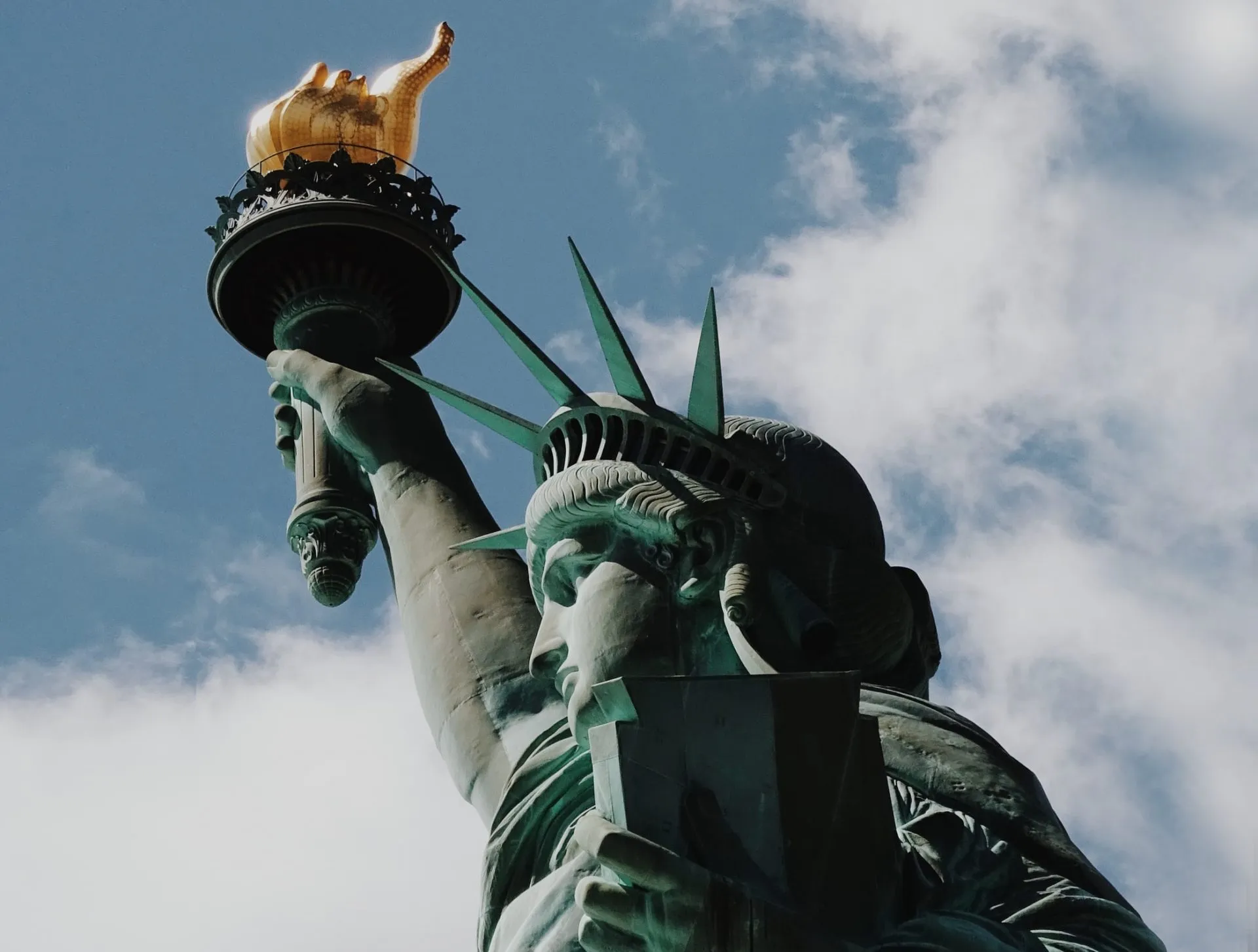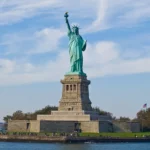The Statue of Liberty, the symbol of freedom that stands tall in New York Harbor, holds more secrets and spooky stories than you might think. From why its torch has been closed for years to how it’s been featured in creepy movies, get ready for a chilling look behind the scenes of this iconic monument. We’ll also reveal the original spot where it was supposed to be placed and the real reason why France gave it to the United States. Let’s dive into the unknown, unraveling the eerie facts that surround the Statue of Liberty.
Creepy Facts About the Statue of Liberty
The Statue of Liberty, that beacon of hope and freedom, has a dark side too. Behind its iconic image lie some spooky secrets, echoing with whispers of sabotage and war.
Remember the torch Lady Liberty holds high? Most people don’t realize you haven’t been able to visit it for over a century! Back in 1916, German agents set off a massive explosion nearby, part of a sabotage campaign during World War I. The “Black Tom” blasts, as they’re known, shook the statue itself, damaging the torch so badly it’s been closed to the public ever since. Imagine the stories those flames could tell if they could talk…
And if you think THAT’s eerie, picture this: During World War II, Lady Liberty became a silent sentinel. Hidden inside her head, the military set up a secret observation post. Soldiers scanned the harbor for enemies, their watchful eyes peering out from the statue’s crown. Can you imagine the tense silence as they guarded the city below, hidden within that towering symbol of freedom?
But the creepiest fact might be the statue’s ever-changing skin. We all know about the green patina, right? It’s from oxidation of the copper. But here’s the thing: that oxidation never stops. The Statue of Liberty is in a constant state of transformation, her color shifting subtly from deep blue-green to almost turquoise. It’s like she’s alive, breathing, evolving with each passing year… makes you shudder a little, doesn’t it?
- Did you know the Statue of Liberty would turn green?
- Have you seen the Statue of Liberty before it turned green?
- Do you know how much the Statue of Liberty is worth?
How has the Statue of Liberty been portrayed in film?
Lady Liberty, with her torch held high, has been a star on the silver screen since the early days of cinema. This iconic landmark has played a variety of roles in movies, sometimes reflecting our hopes and dreams, and other times mirroring our fears and anxieties.
In many films, the Statue of Liberty stands tall as a beacon of hope and freedom. Think of the 1989 film Ghostbusters II, where she literally strides through New York City to lend a helping hand (or should we say, torch?) to the Ghostbusters in their fight against supernatural baddies. Or how about Superman IV: The Quest for Peace from 1987, where Superman swoops in to save a young boy from the crumbling statue, showcasing his commitment to protecting the vulnerable.
But the Statue of Liberty hasn’t always been portrayed in such a positive light. Some movies have cast her as a target for destruction, a symbol of a world on the brink. Take the 1968 film Planet of the Apes, where Charlton Heston stumbles upon the weathered remains of the Statue of Liberty, a chilling reminder of a civilization lost. A similar sentiment is echoed in the 2004 disaster flick The Day After Tomorrow, where a massive tidal wave engulfs Lady Liberty, driving home the message of humanity’s vulnerability in the face of natural disasters.
And then there are the films where the Statue of Liberty becomes a pawn in the hands of supernatural forces. In Ghostbusters II, she falls under the spell of the villainous Vigo the Carpathian, who uses her as a conduit to unleash chaos upon the city. In the alien invasion blockbuster Independence Day, the Statue of Liberty suffers a more devastating fate, obliterated by a powerful alien weapon in a scene meant to underscore the sheer destructive power of the invaders.
These are just a few examples of how filmmakers have used the Statue of Liberty to enhance the narratives of their films. Whether she’s a symbol of hope, a target for destruction, or a pawn in a larger game, Lady Liberty continues to captivate audiences on the big screen, reminding us of the enduring power of this iconic landmark.
What was the original intended location for the Statue of Liberty?
Believe it or not, Lady Liberty wasn’t always meant for New York City. In fact, her grand pose was originally destined for a completely different continent! The sculptor, Frédéric Auguste Bartholdi, first envisioned his colossal creation gracing the entrance of the Suez Canal in Port Said, Egypt.
Imagine that – the Statue of Liberty, a beacon of hope and freedom, standing tall at the crossroads of Asia and Africa. It would have been quite the sight! Bartholdi even designed her as a robed woman, holding a torch high to guide ships through the bustling waterway. He called her “Egypt Bringing Light to Asia.”
Unfortunately, things didn’t quite go as planned. While the Egyptian government initially showed interest in the project, they ultimately backed out due to the sheer cost of the endeavor. Constructing such a massive statue, even back then, was a pricey undertaking, and they simply couldn’t justify the expense at the time.
This turn of events left Bartholdi searching for a new home for his masterpiece. Luckily for us, he eventually set his sights on the United States, and the rest, as they say, is history!
Is it true that the French government gifted the Statue of Liberty to the United States?
You’ve probably heard the story: France gave the United States the Statue of Liberty as a generous present. While it’s true that the statue was a symbol of friendship between the two nations, the actual story is a bit more nuanced. It wasn’t the French government that footed the bill for this iconic landmark. Instead, it was the French people who dug deep into their pockets and raised the funds to build Lady Liberty.
Think of it like a giant crowdfunding campaign, but in the 1880s! People across France, from school children donating their pennies to wealthy citizens making large contributions, all chipped in to make this symbol of freedom a reality. Meanwhile, across the Atlantic, the United States was tasked with finding a suitable spot for this monumental gift – no small feat considering its size! They eventually decided on Liberty Island in New York Harbor, where the statue still stands tall today, welcoming millions of visitors each year.
So, while the French government wasn’t directly involved in gifting the Statue of Liberty, it was truly a joint effort between the people of both countries that made this iconic landmark possible.
FAQ
Q: Why is the Statue of Liberty’s torch closed to the public?
A: The torch has been closed since the “Black Tom” explosions in 1916 due to safety concerns.
Q: How has the Statue of Liberty been portrayed in film?
A: The statue has made numerous appearances in films, including “Ghostbusters II,” “Planet of the Apes,” and “Superman IV.”
Q: What was the original intended location for the Statue of Liberty?
A: The statue was originally intended for the Suez Canal but ended up in New York Harbor instead.
Q: Is it true that the French government gifted the Statue of Liberty to the United States?
A: No, the statue was a gift from the people of France, not the government.
Q: What are the dimensions and materials used in the construction of the Statue of Liberty?
A: The statue is made of copper and stands over 150 feet tall, with a base made from granite.
- Unlock Black Pepper’s Secrets: A Complete Guide - April 26, 2025
- Discover Long Black Pepper: Flavor & Health Benefits - April 25, 2025
- Shocking Twists: The Grownup Review: Unreliable Narration - April 25, 2025
















